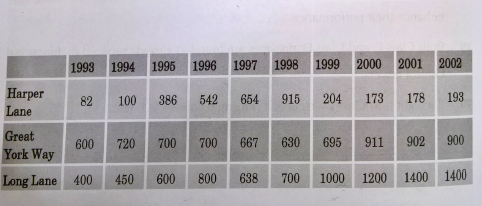You should spend about 20 minutes on this task.
The table below shows the results of a survey of the average number of cars per hour using three suburban roads during working hours in a ten-year pollution monitoring programme. Traffic calming (methods of slowing down traffic, e.g by building raised areas across road) was introduced in Harper Lane at the beginning of 1999. Summarise the information by selecting and reporting the main features, and make comparison where relevant.
Write at least 150 words.

MODEL ANSWER>>>
The survey results of the average number of cars per hour which used three suburban roads during working hours are depicted in the given table.
Overall, the survey which was conducted as a part of 10 year pollution monitoring programme showed positive results in Harper Lane after the introduction of traffic calming, whereas the traffic stood unarrested in the other two lanes.
As per the table, traffic was the worst in the Great York Way, when 600 cars passed through it in an hour. Just behind it stood the Long Lane, with 400 cars, whereas only 82 cars used the Harper Lane.
During the decade from 1993, there was an increase in the volume of cars (300) which passed past the Great York Lane, and this was in an erratic manner. However, in the Long Lane, the hourly use of cars climbed steeply, when the number rose more than three-fold between the years (from 400 to 1400).
In the Harper Lane, the car traffic is seen rising substantially from 82 in 1993 to 915 in 1998. However, the introduction of traffic calming had made it the least car-friendly lane in the consecutive years, when an average of less than 200 cars used it.
Word count: 190